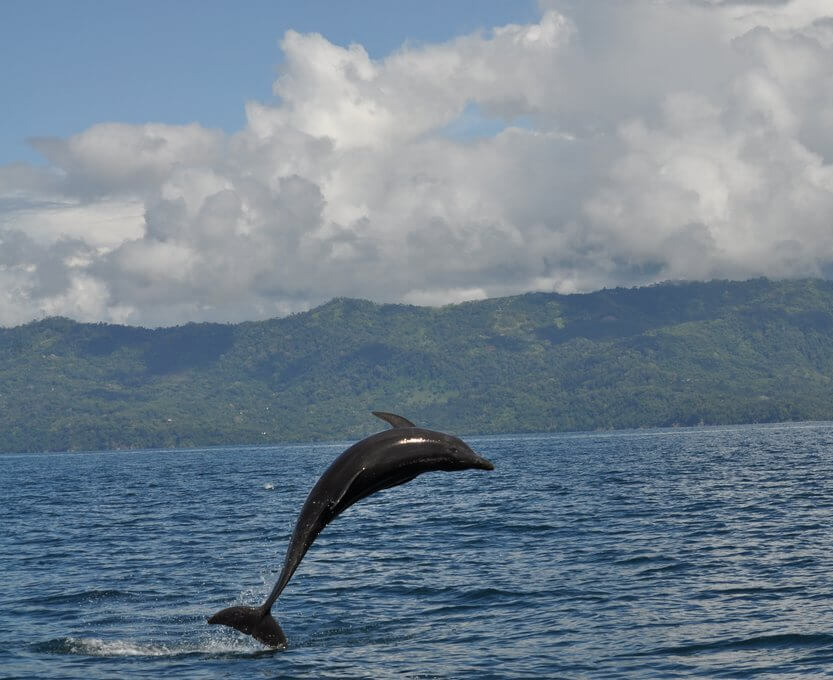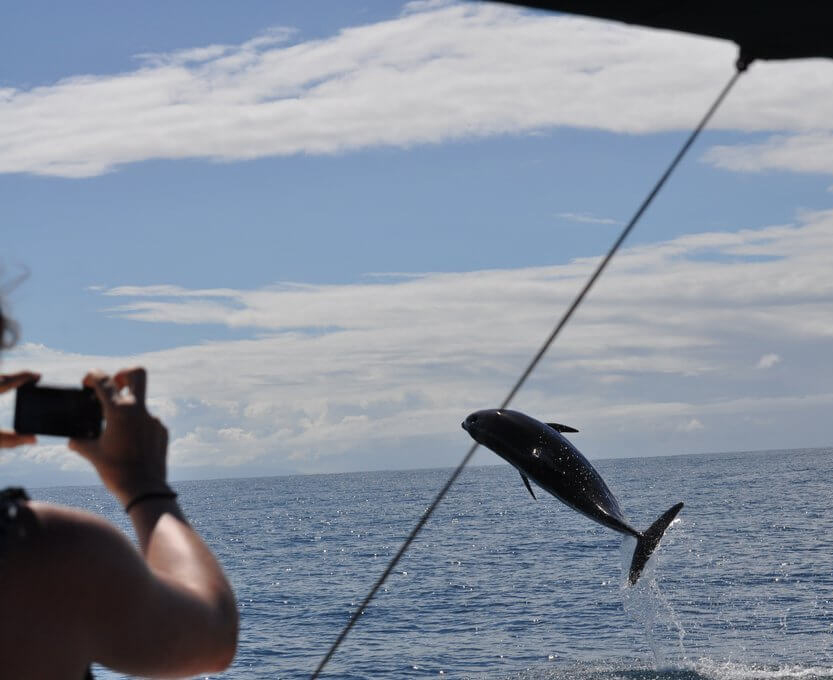Dolphins in Guanacaste
There are several species of dolphins in Guanacaste, in the north west of Costa Rica.

During our catamaran sailing trips, it is extremely common to see them swimming along with the catamaran, usually in the bow, where at the same speed of the catamaran, they swim right in front of the boat, as if they were having fun with the thrust of the catamaran itself.
It is common to see small and medium sized groups, although sometimes we have seen very large groups of dozens or even hundreds of them.
Bottlenose Dolphin
The bottlenose dolphin, also known as the truncated tursio or common dolphin, is the best known and most studied species of dolphin. It is also the most common species in zoos and aquariums around the world. In the wild, the bottlenose dolphin lives along the coasts of tropical and temperate zones between 40ºC S latitude and 45ºC N latitude.

It is a coastal species throughout much of its range and forms groups of no more than 20 individuals, but some varieties live offshore and groups can then consist of as many as 200 animals. The bottlenose dolphin is usually gray or black on the upper parts and somewhat lighter on the lower parts.
It has a large, curves and pointed dorsal fin, with the edge full of notches due to wear, which gives a distinctive character to each individual. Its skull has a prolongation that forms a kind of snout or beak that resembles the neck of a bottle (other dolphin species also have it).
The size of the bottlenose dolphin is variable; it measures between 2 and 4 mt in length depending on the populations. They feed mainly on fish, but can also eat crustaceans, squid and other invertebrates. Bottlenose dolphins take advantage of the fishing boats, which they follow closely to feed on the animals they scare away or on the leftovers and waste thrown overboard. They are very social animals and, at least in some coastal populations, it seems that groups stay together throughout their lives.
The bottlenose dolphin communicates with the other members of its group by means of a rich repertoire of sounds; on the other hand, it seems that in some populations individuals emit their own characteristic sound that differentiates them from the rest. Two species typical of the North Pacific are found in the coastal strip of Latin America: one reaches Mexico and the other extends as far as Panama.
Pacific Spotted Dolphin
The Pacific spotted dolphin is known for the persecution it suffered from tuna fisheries in the eastern tropical Pacific. Millions of dolphins died as a result of the use of setting nets, a type of tuna net in which the dolphins were trapped. Despite legislation and catch limits imposed since then, bycatch is still a major threat to this species.
Two subspecies of the Pacific spotted dolphin are currently recognized: a coastal form S. a. attenuata, found in coastal waters of the eastern tropical Pacific, and an open ocean form S. a. graffmani, found throughout the rest of its range.
The Pacific spotted dolphin is a slender, medium-sized cetacean. Its falcate dorsal fin is pointed and very narrow and the pectoral fins are pointed, small and dark on both sides. It has a dark gray mantle, which widens on the flanks in the middle region of the body, and then reduces towards the back, behind the dorsal fin. The sides and belly are lighter gray. As its name indicates, the body is covered with spots to varying degrees, depending on age and location, with individuals in some areas having few or no spots.
The coastal subspecies is usually larger, more robust, with a thicker bill and more spots. The lips and bill tip are white and a dark band runs from the mandible to the pectoral fin on both sides.
Hatchlings are born without spots and have a dark gray mantle and very pale sides and belly. Juveniles develop dark spots on the belly and lighter spots on the dorsal region. The number of spots increases with age, becoming fused together in older animals. There is a wide range of variation in size and coloration.
This species can be confused with several other oceanic species of long-beaked dolphins, including spinner dolphins, bottlenose dolphins and Atlantic spotted dolphins in areas where the two species overlap. The identifying characteristics of the spotted dolphin are its smaller, more slender size, distinctive dorsal mantle and smaller, narrower dorsal fin. They grow up to 2.5 m. long and weigh around 120 kg.
This species can be confused with several other oceanic species of long-beaked dolphins, including spinner dolphins, bottlenose dolphins and Atlantic spotted dolphins in areas where the two species overlap. The identifying characteristics of the spotted dolphin are its smaller, more slender size, distinctive dorsal mantle and smaller, narrower dorsal fin. They grow up to 2.5 m. long and weigh about 120 kg.
Pacific spotted dolphins are very active and acrobatic, often performing high, sideways jumps. They are fast swimmers and perform long, low jumps at high speeds. They are known to swim in the bow and wake of boats throughout most of their range, although they generally avoid boats in the tropical eastern Pacific, where they have been persecuted for many years. The coastal form tends to be found in groups of less than 100 individuals, while offshore groups tend to number 2,000 to 3,000 individuals. Pacific spotted dolphins can often be seen in association with other oceanic dolphin species and yellowfin tuna, a behavior that has historically been exploited by tuna fishermen.
Sexual maturity is reached at 7 years in males and 6 years in females, and they breed every 2 to 4 years. Gestation and lactation last 11 months. Life expectancy is approximately 40 years.
The Pacific spotted dolphin is found in a band around the world in tropical and subtropical waters, preferring areas where the surface water temperature is above 25º C.
In addition to being seriously threatened by bycatch, as they are taken as bycatch by various fisheries around the world, they are hunted for human consumption in large numbers in Japan and in smaller numbers in other countries around the world. Other threats to the species include habitat degradation and anthropogenic disturbance.
There is no global population estimate for the species, although it is believed to be one of the most abundant cetaceans in the world. However, some populations, such as the offshore population in the northeastern Pacific, which was targeted by tuna fisheries, are not believed to be recovering from previous exploitation.
Spinner dolphins
The spinner dolphin or long-snouted acrobat (Stenella longirostris) is a species of odontocete cetacean in the family Delphinidae. It is a small dolphin that inhabits tropical seas around the world. It is famous for its acrobatic jumps in

